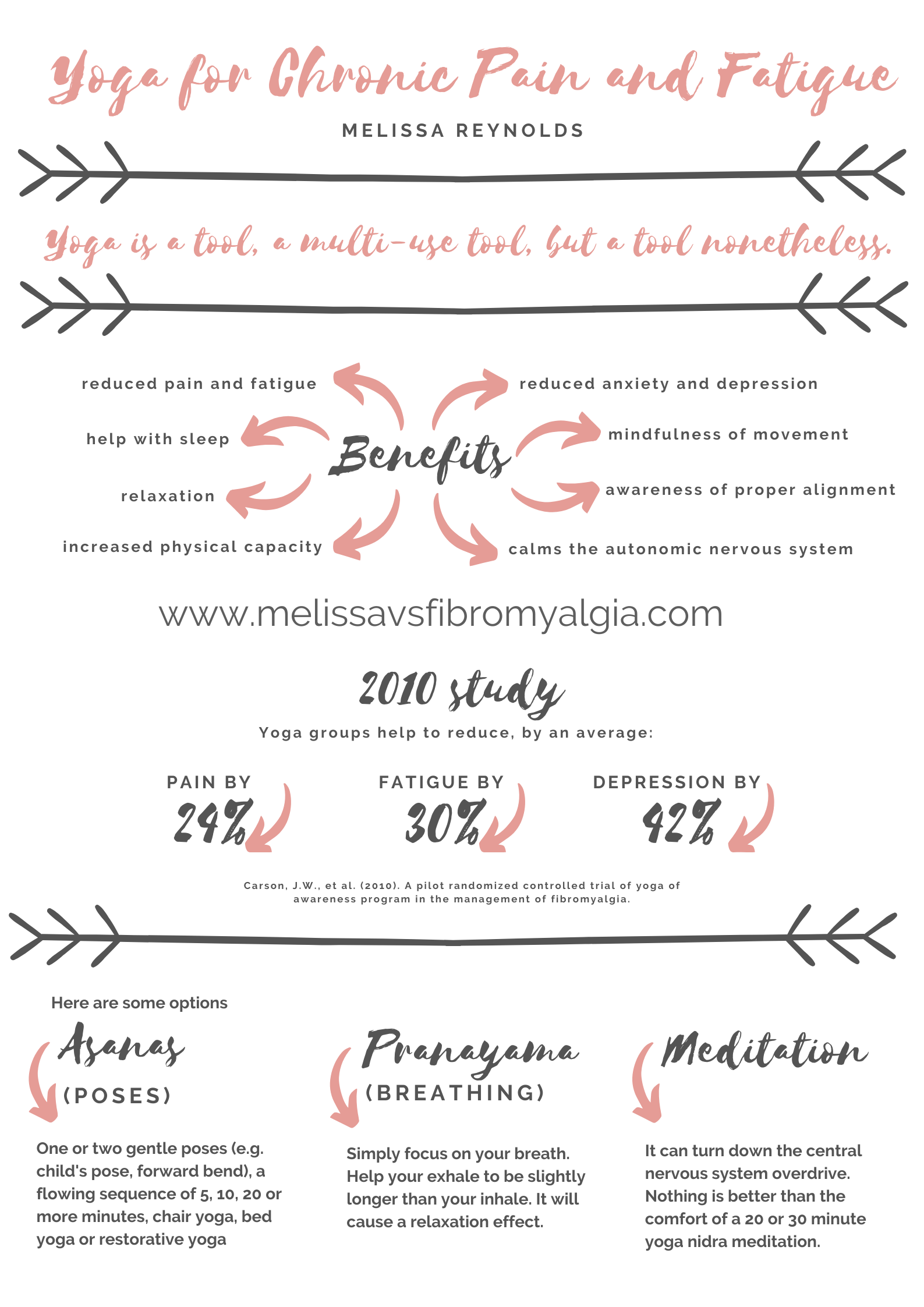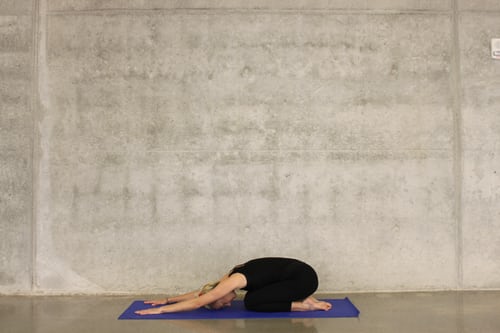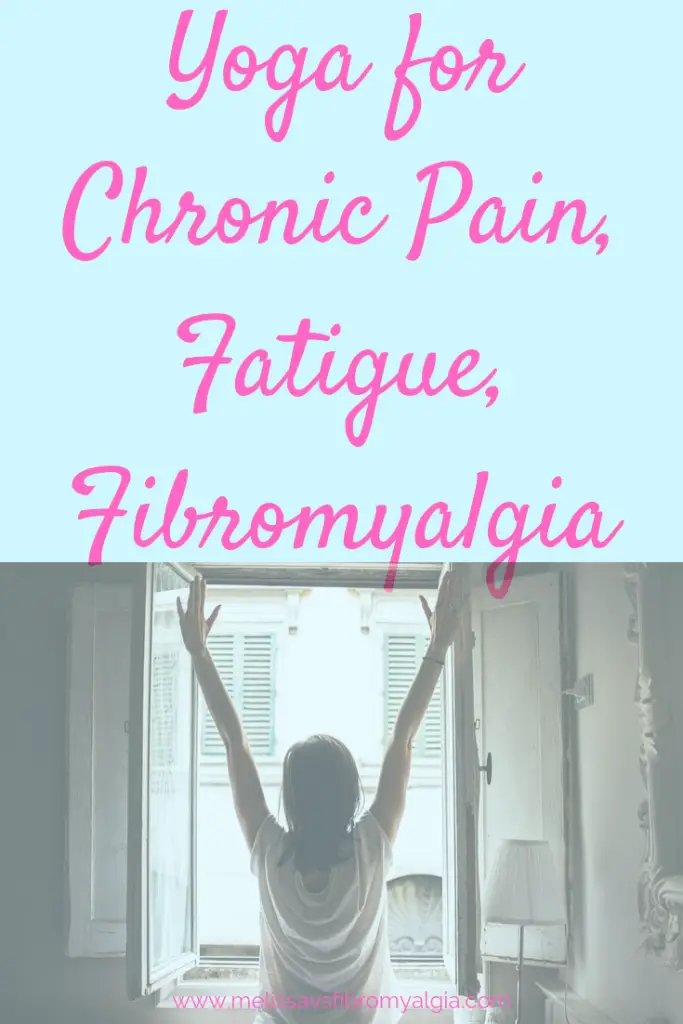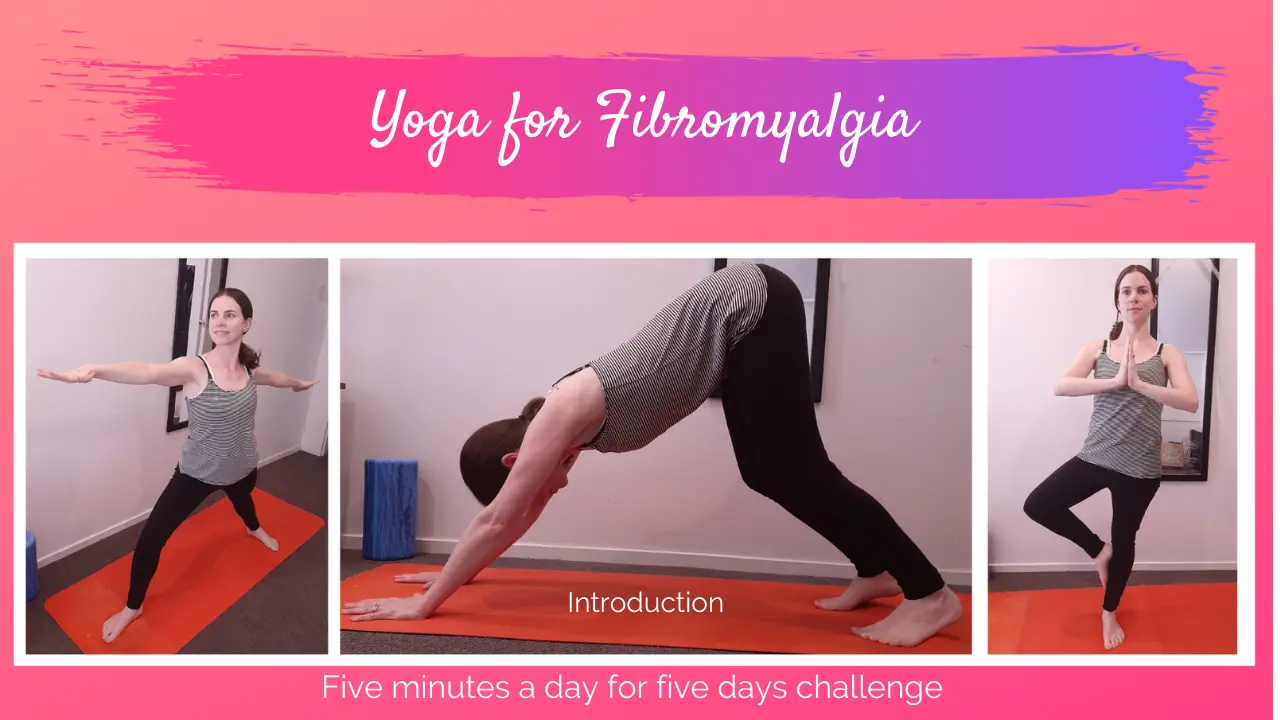I have been dabbling with yoga for chronic pain and fatigue for more than 10 years. For the past five I have progressively become more enamoured with it.
In this post I will share some research, the benefits (in brief), the thing I love most about yoga, it’s multiple uses for chronic pain and fatigue, specific ways I use it, and how you can learn more about incorporating it into your well being journey.
Let’s be clear right out of the gate. Yoga is not a panacea. It is not a cure all. It is one useful tool that can be a part of a holistic plan for wellness.

Type “yoga for fibromyalgia” or “yoga for myofascial pain syndrome” or “yoga for pain” etc. And you will find a wealth of search options to delve into.
There is research specifically for using poses for myofascial pain syndrome, fibromyalgia and more. Taking a more macroscopic view, mindfulness for chronic illness is just as much of a buzz topic at the moment.
Research around Yoga, Pain and Fatigue
Take this 2010 study that found, “pain was reduced in the yoga group by an average of 24 percent, fatigue by 30 percent and depression by 42 percent.” The yoga group participated in a holistic program for eight weeks – gentle yoga poses, meditation, breathing exercises, yoga-based coping instructions, group discussions and a daily diary assessing their progress. The control group received standard medication treatments.
This was followed up three months later: “Follow-up results showed that patients sustained most of their post treatment gains, with the FIQR (Fibromyalgia Impact Questionnaire Revised) Total Score remaining 21.9% improved at 3 months. Yoga practice rates were good, and more practice was associated with more benefit for a variety of outcomes.”
This study was small, just eight participants completed the study on the effect of yoga on myofascial pain syndrome in the neck. It comprised two weeks of breathing and relaxation practices and two weeks of asanas (poses), breathing and relaxation. The poses were Trikonasan (triangle pose), Tadasan (mountain pose), Vakrasan (twisted pose), Balasan (child’s pose) and Vajrasan (thunderbolt pose).
However, let’s not lose sight here – Vajrasan is a more advanced pose, the ability to do this pose indicates a pretty high level of physical ability to me.
The results were that this program “led to significant improvement in the quality of health, physical capacity (strength), cervical range of motion, and pressure threshold of the trigger points, and decreased the disability and pain.”
Perspectives on Yoga Inputs in the Management of Chronic Pain describes the benefits: “This consists of decreased metabolism,[24] decreased rate of breathing, decreased blood pressure, decreased muscle tension, decreased heart rate and increased slow brain [alpha] waves.[25] As the neural discharge pattern gets corrected, the habitual deep muscle hyper tonicity and thus the static load on postural muscle also slowly come down. The function of viscera improves with the sense of relaxation and sleep gets deeper and sustained. The fatigue level comes down.”

Benefits of yoga for chronic pain and fatigue (or anyone)
• calms the autonomic nervous system
• help with sleep
• reduced fatigue
• reduced pain
• increased physical capacity
• decreased myofascial pain
• less anxiety
• reduced depression
• relaxation
• mindfulness of movement
• awareness of proper alignment
What I love the most about yoga for managing chronic pain and fatigue:
Ease of adapting to my current abilities -Whatever my symptom level on any given day there is an option for me to practice yoga.
Let’s talk a couple of key things here:
Yoga is a tool, a multi use tool, but a tool nonetheless. I will use any tool at my disposal to help with the symptoms I live with. In much the same way I use low dose naltrexone- it was not designed for fibromyalgia or myofascial pain syndrome but it helps anyway.
If some parts of the spectrum of yoga practices don’t resonate with you, ignore them. If you want to look at it as a purely physical practice, then do so.
In terms of the spiritual side, I shy away from much if it. My belief practice is Christianity and I have never felt a conflict. In fact, there is a great Christian yoga channel on YouTube.

Some of the options in yoga
Asanas (poses): one or two gentle poses (like child’s pose and forward bend), a flowing sequence of 5, 10, 20 or more minutes, chair yoga, bed yoga or restorative yoga.
Pranayama (breathing): breathing is always useful when you are managing a chronic illness. Simply focusing on your breath and helping your exhale to be slightly longer than your inhale will cause a relaxation effect. Breathing through pain, fatigue, stress, anxiety and overwhelm can help centre your thoughts on something else, release tension and help to ease the symptoms. Synchronising movements with the breath makes you more likely to be mindful of your movement and less likely to overdo it or injure yourself.
Meditation: I began using meditation specifically to achieve rest where sleep provided little. It was a means to an immediate end. After a few years I realised it was helping me much more profoundly in the form of turning down my central nervous system overdrive. There is nothing better than the comfort I feel after a 20 or 30 minute yoga nidra meditation. I cannot achieve it another way.
Day to day my practice changes but I usually practice in one way or another.
Meditation is my top tool for managing fatigue and pain. I very rarely miss my daily meditation.
I have never completed a 60 or 90 minute class or resembled a pretzel in any way. Because that is not the point.
Strengthening, calming, being mindful and moving is.
When my first son was young I had a yoga instructor come to my house for a private session to ensure my posture was correct and craft a sun salutation sequence suitable for my physical abilities at the time.
Sometimes I do the sequence with several breaths for each pose, one breath for each pose or a mix. If I feel a particular benefit from one of the poses I will engage in that one longer. Forward bend is a particularly good one for letting the neck gently stretch.
Cat and cow pose is a great tiny sequence for the pelvis and back. I did this multiple times a day during my pregnancies. I teach cat and cow pose in my free challenge, Five Minutes a Day for Five Days Challenge, sign up here.
When my pelvis was unstable due to pregnancy and I could hardly walk, I could still do half sun salutations (standing) or chair salutations.
The key is to be mindful of your body on any given day. Pay attention to what you need and can reasonably do.
Learn the many options- these tools have a place in our natural pain relief toolkit.
The complexity in yoga for chronic pain and fatigue
When we have extra challenges to think through, we need to be extra mindful.
There is some complexity involved in practicing yoga when you have chronic issues. This is why it can be helpful to see a teacher privately – either for some initial guidance or ongoing personalised work.
There are several types of yoga, many asana (poses) to choose from and we need to choose sequences that make sense for our current context. The other bonus is that you can create a homework plan so that you can continue your work between sessions, equipping you further.
As an example of the complexity – I have severe, recurring trigger points in my neck and shoulders. Holding poses that activate these muscles for up to five minutes (yin yoga) is not a good idea for me. I have a heat intolerance so hot yoga isn’t for me. The fibromyalgia and poor tense fascia responds well when given a chance to gently release. So I gravitate toward slow flow and gentle yoga.
I trained to be a yoga teacher because I got so frustrated with doing “beginner” classes that we out of my reach physically and for the time frame. I also wanted to share these tools to show you that “yoga” doesn’t mean 90 minute classes getting into very bendy positions.
This is also why I created the below challenge!
Learn how we can use the tools of yoga in just five minutes a day?
Join us for the challenge!

Join us for five minutes per day for five days and see how the tools of yoga might be of service to you.
I’d love to hear from you – have you found benefit from any of the tools of yoga?



One thought on “Yoga for Chronic Pain and Fatigue”